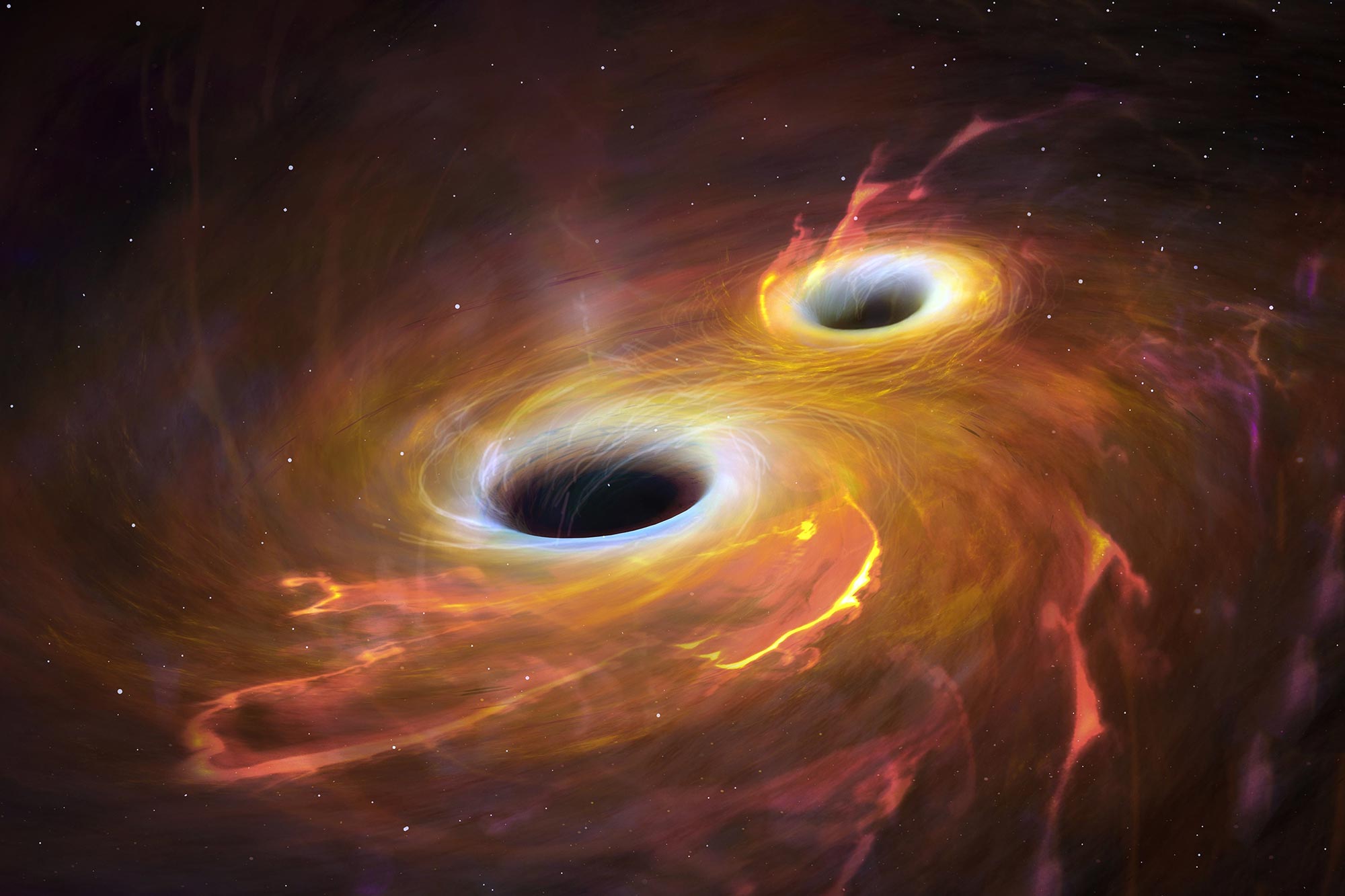
Eine künstlerische Darstellung von zwei schwarzen Löchern, die kurz vor der Kollision stehen.
Neue Beobachtungen und Analysen zeigen zwei schwarze Goliath-Löcher, die nur 750 Lichtjahre voneinander entfernt sind und sich nähern und sich nach einer Galaxienverschmelzung gegenseitig umkreisen.
Astronomen des Flatiron Institute und ihre Kollegen haben zwei gespenstische Goliaths auf dem Weg zu einem katastrophalen Treffen entdeckt. Die Astronomen machten die Ankündigung am 9. Januar auf dem Treffen der American Astronomical Society in Seattle und in einem in der Zeitschrift veröffentlichten Artikel Astrophysikalische Zeitschriftenbriefe.
Obwohl kosmisch dicht beieinander liegende supermassereiche Schwarze Löcher nur 750 Lichtjahre entfernt sind, werden sie erst in ein paar hundert Millionen Jahren verschmelzen. In der Zwischenzeit liefert die Entdeckung der Astronomen eine bessere Schätzung der Anzahl der supermassereichen Schwarzen Löcher, die ebenfalls kurz vor einer Kollision im Universum stehen.

Die Konzeption dieses Künstlers zeigt eine galaktische Verschmelzung im Spätstadium und zwei neu entdeckte zentrale Schwarze Löcher. Binäre Schwarze Löcher sind am nächsten bei mehreren Wellenlängen beobachtet. Kredit: ALMA (ESO/NAOJ/NRAO); Mutter. Weiss (NRAO/AUI/NSF)
Diese verbesserte Anzahl von Scheitelpunkten wird Wissenschaftlern dabei helfen, sich auf den universumübergreifenden Chor intensiver Wellen in der Raumzeit einzustimmen, die als bekannt sind[{“ attribute=““>gravitational waves, the largest of which are products of supermassive black holes close to collision in the aftermath of galaxy mergers. Detecting that gravitational-wave background will improve estimates of how many galaxies have collided and merged in the universe’s history.
The short distance between the newly discovered black holes “is fairly close to the limit of what we can detect, which is why this is so exciting,” says study co-author Chiara Mingarelli, an associate research scientist at the Flatiron Institute’s Center for Computational Astrophysics in New York City.
Due to the small separation between the black holes, the astronomers could only differentiate between the two objects by combining many observations from seven telescopes, including NASA’s Hubble Space Telescope. (Although supermassive black holes aren’t directly visible through an optical telescope, they are surrounded by bright bunches of luminous stars and warm gas drawn in by their gravitational pull.)

Telescope observations of two newly discovered supermassive black holes on a collision course. Their host galaxy, left, is a mash-up of two galaxies that have collided. The pink box shows the location of the supermassive black holes. Close observation of the pair, right, reveals two distinct black holes (white spots) only 750 light-years apart. Credit: M.J. Koss et al.
The astronomers found the pair quickly once they started looking, which means that close-together supermassive black holes “are probably more common than we think, given that we found these two and we didn’t have to look very far to find them,” Mingarelli says.
The newly identified supermassive black holes inhabit a mash-up of two galaxies that collided around 480 million light-years away from Earth. Gargantuan black holes live in the heart of most galaxies, growing bigger by gobbling up surrounding gas, dust, stars, and even other black holes. The two supermassive black holes identified in this study are true heavyweights: They clock in at 200 million and 125 million times the mass of our sun.
The black holes met as their host galaxies smashed into each other. Eventually they will begin circling each other, with the orbit tightening as gas and stars pass between the two black holes and steal orbital energy. Ultimately the black holes will start producing gravitational waves far stronger than any that have previously been detected, before crashing into each other to form one jumbo-size black hole.
Die Konzeption dieses Künstlers zeigt eine galaktische Verschmelzung im Spätstadium und zwei neu entdeckte zentrale Schwarze Löcher. Binäre Schwarze Löcher sind am nächsten bei mehreren Wellenlängen beobachtet. Kredit:[{“ attribute=““>ALMA (ESO/NAOJ/NRAO), M. Koss et al (Eureka Scientific), S. Dagnello (NRAO/AUI/NSF)
Prior observations of the merging galaxies saw only a single supermassive black hole: Because the two objects are so close together, scientists couldn’t definitively tell them apart using a single telescope. The new survey, led by Michael J. Koss of Eureka Scientific in Oakland, California, combined 12 observations made on seven telescopes on Earth and in orbit. Although no single observation was enough to confirm their existence, the combined data conclusively revealed two distinct black holes.
“It’s important that with all these different images, you get the same story — that there are two black holes,” says Mingarelli, when comparing this new multi-observation research with previous efforts. “This is where other studies [of close-proximity supermassive black holes] Sie fielen in die Vergangenheit. Als die Leute ihnen folgten, stellte sich heraus, dass es nur ein Schwarzes Loch gab. [This time we] Viele Notizen, alle übereinstimmend.

Schematische Darstellung der wichtigsten Stadien und entscheidenden physikalischen Mechanismen, die die Verschmelzung zweier supermassiver Schwarzer Löcher antreiben, und der entsprechenden repräsentativen Zeit- und Raumskalen. Bildnachweis: José Utreras/Ezequiel Treister, Zentrum für Astrophysik und zugehörige Technologien (CATA); Michael Koss (Eureka Scientific), et al.
Sie und der Gastwissenschaftler Andrew Casey Clyde vom Flatiron Institute nutzten die neuen Beobachtungen, um die Population von verschmelzenden supermassereichen Schwarzen Löchern im Universum abzuschätzen, und stellten fest, dass sie „überraschend hoch sein könnte“, sagt Mingarelli. Sie sagen eine Fülle von Paaren supermassiver Schwarzer Löcher voraus, die eine große Menge ultrastarker Gravitationswellen erzeugen. All diese Hektik sollte zu einem lauten Gravitationswellenhintergrund führen, der leichter zu erkennen ist, als wenn die Bevölkerung kleiner wäre. Die allererste Entdeckung von Gravitationswellen im Hintergrund könnte „sehr bald“ erfolgen, sagt Mingarelli.
Referenz: „UGC 4211: Doppelt aktive galaktische Kerne im lokalen Universum bei 230 PS nuklearer Trennung bestätigt“ von Michael J. Benny Trachtenbrot, Franz E. Bauer, George C. Brevon, Claudio Ricci, Richard Moshotsky, Loreto Barcus-Muñoz, Laura Plesha, Thomas Connor, Fiona Harrison, Tingting Liu, Macon Magno, Chiara MF Mingarelli, Francesco Mueller-Sanchez, Kyosuke Oh , Taro Shimizu, Krista Lynn Smith, Daniel Stern, Miguel Parra Tello und C. Megan Urey 9. Januar 2023, hier verfügbar. Astrophysikalische Zeitschriftenbriefe.
DOI: 10.3847/2041-8213/aca8f0








